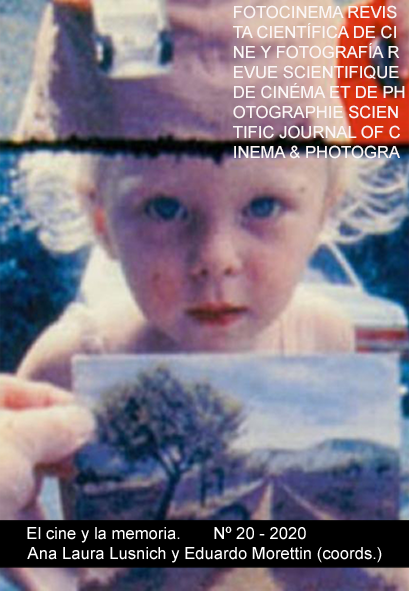Coup D’État in Brazil (1964) seen from a Soviet newsreel
DOI:
https://doi.org/10.24310/Fotocinema.2020.v0i20.7590Keywords:
History and Cinema, Newsreel, Brazil, Soviet Union, Coup d’État, Cold War, Visual HistoryAbstract
This article proposes a historical and theoretical reflection on the links between visual records and the construction of the memory of a political event, analyzing the specific case of the 1964 Coup d'État in Brazil that overthrew the center-left president João Goulart and became an important Cold War event in Latin America. This event, which inaugurated 20 years of military dictatorship in Brazil, was recorded in images that became matrices of social memory, in which there is a dominant figuration of defeat and the absence of popular resistance to the coup troops. However, from a fragment of a Soviet newsreel, I analyze rare images of a mass protest against the ongoing coup d'État. These records help us to problematize the predominant memory and its visual supports, suggesting the possibility of another visual and political history of the 1964 Coup.
Downloads
Metrics
References
Archangelo, R. (2015). Imagens da nação: política e prosperidade nos cinejornais Notícias da Semana e Atualidades Atlântida (1956-1961). Tese de Doutorado em História Social. São Paulo: Universidade de São Paulo.
Arendt, H. (2014). Entre o passado e o futuro. São Paulo: Editora Perspectiva, 7ª edição.
Bandeira, L. A. Moniz (2010). O governo João Goulart: as lutas sociais no Brasil. São Paulo: Editora UNESP (8ªedição).
Carvalho, A. (2010). A rede da democracia: O Globo, O Jornal e o Jornal do Brasil na queda do governo Goulart (1961-64). Niterói: EDUFF.
Didi-Huberman, G. (1998). O que vemos, o que nos olha. São Paulo: Editora 34.
Dreifuss, R. A. (2006). 1964: A conquista do Estado. Ação política, poder e golpe de classe. Petrópolis: Vozes (2ªed.).
Figueiredo, A. (1993). Democracia ou Reformas. Alternativas democráticas à crise política: 1961-1964. Rio de Janeiro: Paz e Terra.
Ianni, O. (1975). O Colapso do populismo no Brasil. Rio de Janeiro: Editora Civilização Brasileira (3ªedição).
Morettin, E. (2003). O cinema como fonte histórica na obra de Marc Ferro. História: Questões & Debates, 38, 11-42.
Napolitano, M. (1999). Como usar TV em sala de aula. São Paulo: Contexto
Napolitano, M. (2014). História do Regime Militar Brasileiro. São Paulo: Contexto.
Napolitano, M. (2015). Recordar é vencer: as dinâmicas e vicissitudes da construção da memória sobre o regime militar brasileiro. Antíteses, 8, 9-44.
Nora, P. (1972). L’evénement monstre. Communications, 18, 162-172.
Polydoro, F. (2015). Vigilância, participação e resistência em imagens de manifestações de rua. In: E. Jesus, E. Trindade, J. Janotti Jr. y M.Roxo (orgs.). Reinvenção comunicacional da política: modos de habitar e desabitar o século XXI (pp. 251-266). Salvador/Brasília: Edufba Compós.
Reis Filho, D. A. (2014). Uma estranha derrota. O Globo, 25/3/2014, disponível em https://oglobo.globo.com/opiniao/uma-estranha-derrota-11971494, acessado em 14/8/2019
Ribeiro, D. (2014). Da crise política ao golpe de Estado. São Paulo: Hucitec.
Rollemberg, D. (2014). O esquecimento das memórias. In: J.R. Martins Filho (Org). O golpe de 64 e o Regime Militar (pp.81-92). São Carlos: EDUFSCAR.
Saliba, E. (2014). As imagens canônicas e a História. In: E. Saliba; M.H. Capelato, E. Morettin y M. Napolitano. (Org.). História e Cinema (pp. 85-96). São Paulo: Alameda Editorial (3ªed).
Veron, E. (1980). Construire l’Evénement. Paris: Minuit.
Xavier, I. (2009). Progresso, disciplina fabril e descontração operária. Retóricas do documentário brasileiro silencioso. Art Cultura, v.11, nº 18, 9-24.
Downloads
Published
How to Cite
Issue
Section
License
All contents published in Fotocinema Revista científica de cine y fotografía are protected under the Creative Commons Attribution-NonCommercial-ShareAlike 4.0 International (CC BY-NC-SA 4.0) license. All about this license is available in the following link: <http://creativecommons.org/licenses/by-nc-sa/4.0>
Users can copy, use, redistribute, share and exhibit publicly as long as:
- The original source and authorship of the material are cited (Journal, Publisher and URL of the work).
- It is not used for comercial purposes.
- The existence of the license and its especifications are mentioned.
There are two sets of authors’ rights: moral and property rights. Moral rights are perpetual prerogatives, unrenounceable, not-transferable, unalienable, imprescriptible and inembargable. According to authors’ rights legislation, Fotocinema. Revista científica de cine y fotografía recognizes and respects authors moral rights, as well as the ownership of property rights, which will be transferred to University of Malaga in open access. The property rights are referred to the benefits that are gained by the use or the dissemination of works. Fotocinema. Revista científica de cine y fotografía is published in an open access form and it is exclusively licenced by any means for doing or authorising distribution, dissemination, reproduction, , adaptation, translation or arrangement of works.
Authors are responsable for obtaining the necessary permission to use copyrighted images.













13.png)




